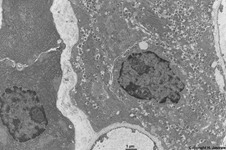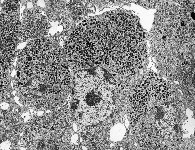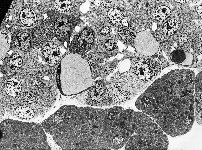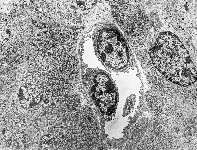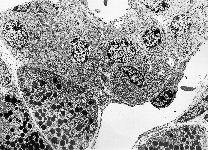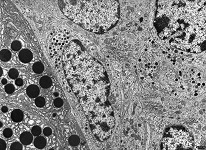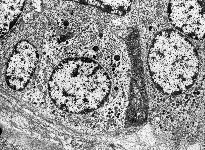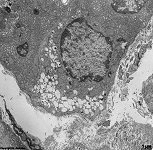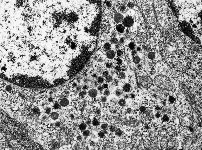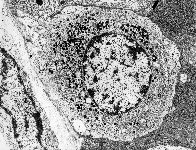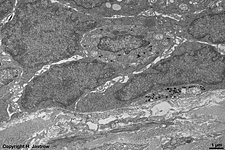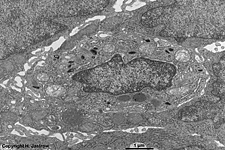English name(s)
Terminologia histologica |
secreted hormone
(synonymes) |
effect(s) |
further information
(molecular weight in Dalton) |
| Pancreas |
|
|
|
A - Cell, alpha-cell, glucagon cell
Endocrinocytus A, Glucagonocytus |
Glucagon |
raises blood glucose level, increases glycogenolysis
in the liver, raises gluconeogenesis and
fatty acid oxidation
in the liver, enhances storage of fatty
acids in form of triglycerids |
protein of 29 amino acids,
molecular weight: 3,483 |
B - Cell, beta-cell, insulin cell
Endocrinocytus B, Insulinonocytus |
Insulin |
anabol: decreases blood glucose level, increases number of GLUT-
transporters in cell membranes of
heart-
and skeletal muscle cells
as well as fat cells which raises their
permeability for glucose,
enhances synthesis of glycogen in the
liver,
reduces gluconeogenesis |
protein of 51 amino acids,
molecular weight: ~ 6,000,
5 min. half-life time, binds to
membrane receptor with
tyrosinkinase activity |
D - Cell, delta-cell, somatostatin cell
Endocrinocytus D, Somatostatinocytus |
Somatostatin |
GH-IH = Growth Hormone inhibiting hormone,
antagonist of GH-RH (Growth Hormone releasing hormone),
inhibits A-cells & exocrine pancreas
in paracrine manner,
also inhibits B-cells in higher concentration |
2 active forms:
1.) somatostatin-14
protein of 14 amino acids,
2.) somatostatin-28
protein of 28 amino acids |
VIP - Cell, delta1-cell, D1-cell
Endocrinocytus D1 |
VIP = vasoactive
intestinal polypeptide |
decreases contraction of smooth muscle cells
of vessels
--> widening of vessel lumen = vasodilatation |
protein of 28 amino acids,
molecular weight: 3,328 |
EC - Cell, enterochromaffin cell
Endocrinocytus EC |
Serotonin
= 5 Hydroxytryptamine
= Enteramine |
stimulation of smooth muscle cells
1. of vessels --> reduction of lumen
= vasoconstriction,
2. of the gut --> stimulation of motility of the gut |
mol. mass: 176,22 g/mol
summary formula:
C10H12N2O |
PP - Cell, pancreatic polypeptide cell
Endocrinocytus PP |
pancreatic
polypeptide |
enhances satiety |
protein of 36 amino acids |
PYY - Cell, peptide YY cell
Endocrinocytus PYY |
peptide YY
= peptide tyrosin-tyrosin |
blood level increases after food intake, inhibits appetite
inhibits motility and emptying of the stomach,
stimulates resorbtion of water and salt in the colon |
protein of 36 amino acids |
Ghrelin - secreting Cell
Endocrinocytus secretans grehlinum |
Ghrelin |
blood level increases when getting hungry,
stimulates secretion of neuropeptide Y (NPY) in the brain, highly
increased in Prader-Willi-syndrome --> missing of satiety |
protein of 28 amino acids,
molecular weight: 3,240 |
pancreatic G - Cell, pancreatic gastrin
cell
Endocrinocytus G pancreaticus |
Gastrin |
stimulates secretion in stomach, especially
of HCl,
activates motoric activity of the Antrum pyloricum,
prolongs emptying of the stomach |
protein of 17 amino acids,
molecular weight: 2,117 |
| stomach |
|
|
|
G - Cell, gastrin cell
Endocrinocytus G |
Gastrin |
stimulates secretion in stomach, especially
of HCl,
activates motoric activity of the Antrum pyloricum,
prolongs emptying of the stomach |
protein of 17 amino acids,
molecular weight: 2,117 |
D - Cell, delta-cell, somatostatin
cell
Endocrinocytus D, Somatostatinocytus |
Somatostatin |
decreases production of enzymes in exocrine pancreas,
inhibits Gastrin and Pepsin,
GH-IH = Growth Hormone inhibiting hormone,
antagonist of GH-RH (Growth Hormone releasing hormone) |
2 active forms:
1.) somatostatin-14
protein of 14 amino acids,
2.) somatostatin-28
protein of 28 amino acids |
EC - Cell, enterochromaffin cell
Endocrinocytus EC |
Serotonin
= 5 Hydroxytryptamin
= Enteramin |
stimulation of smooth muscle cells
1. of vessels --> reduction of lumen
= vasoconstriction,
2. of the gut --> stimulation of motility of the gut |
mol. mass: 176,22 g/mol
summary formula:
C10H12N2O |
ECL - Cell, enterochromaffin-like
cell, histamine cell
Endocrinocytus ECL |
Histamine |
decreases contraction of smooth muscle cells
of vessels
--> widening of vessel lumen = vasodilatation,
stimulates H2 receptors of parietal cells in the stomach
--> increase of production of HCl |
mol. mass: 111,15 g/mol
summary formula:
C5H9N3 |
NO - Cell, brush cell, tuft cell
Epitheliocytus penicillatus |
Nitrogenmonoxide
= NO |
decreases contraction of smooth muscle cells
of vessels
--> widening of vessel lumen = vasodilatation |
no typical enteroendocrine cell |
| gut: Duodenum, Jejunum,
Ileum,
Caecum, Colon |
|
|
|
A - Cell, alpha-cell, glucagon cell
Endocrinocytus A, Glucagonocytus |
Glucagon |
raises blood glucose level, increases glycogenolysis
in the liver, raises gluconeogenesis and
fatty acid oxidation
in the liver, enhances storage of fatty
acids in form of triglycerids |
protein of 29 amino acids,
molecular weight: 3,483 |
B - cell, beta-cell, insulin cell
Endocrinocytus B, Insulinonocytus |
Insulin |
anabol: decreases blood glucose level, increases number of GLUT-
transporters in cell membranes of
heart-
and skeletal muscle cells
as well as fat cells which raises their
permeability for glucose,
enhances synthesis of glycogen in the
liver,
reduces gluconeogenesis |
protein of 51 amino acids,
molecular weight: ~ 6,000,
5 min. half-life time, binds to
membrane receptor with
tyrosinkinase activity |
D - Cell, delta-cell, somatostatin
cell
Endocrinocytus D, Somatostatinocytus |
Somatostatin |
GH-IH = Growth Hormone inhibiting hormone,
antagonist of GH-RH (Growth Hormone releasing hormone) |
2 active forms:
1.) somatostatin-14
protein of 14 amino acids,
2.) somatostatin-28
protein of 28 amino acids |
EC - Cell, enterochromaffin cell
Endocrinocytus EC |
Serotonin |
stimulation of smooth muscle cells
1. of vessels --> reduction of lumen
= vasoconstriction,
2. of the gut --> stimulation of motility of the gut |
mol. mass: 176,22 g/mol
summary formula:
C10H12N2O |
ECL - Cell, enterochromaffin-like
cell, histamine cell
Endocrinocytus ECL |
Histamine |
decreases contraction of smooth muscle cells
of vessels
--> widening of vessel lumen = vasodilatation,
stimulates H2 receptors of parietal cells in the stomach
--> increase of production of HCl |
mol. mass: 111,15 g/mol
summary formula:
C5H9N3 |
G - Cell, gastrin cell
Endocrinocytus G |
Gastrin |
stimulates secretion in stomach, especially
of HCl,
activates motoric activity of the Antrum pyloricum,
prolongs emptying of the stomach |
protein of 17 amino acids,
molecular weight: 2,117 |
I - Cell, cholescystokinin cell, CCK
cell
Endocrinocytus I |
Cholescystokinin |
stimulation of smooth muscle cells in
the wall of the gall bladder and decreases
contraction of the Musculus sphincter oddi --> emptying of the gall
bladder,
increases emzyme production of the exocrine pancreas |
protein of 8, 22, 33 or 58
amino acids |
K - endocrinocyte, glucose dependent
insulin release peptide cell, GIP cell
Endocrinocytus K |
gastrointestinal
polypeptide = GIP |
stimulates glucose-dependent release of insulin |
protein of 42 amino acids,
molecular weight: 4,980 |
L - Cell, glucagon like peptide 1
cell, GLP1 cell
Endocrinocytus L |
glucagon like peptide 1
= GLP 1 |
stimulates release of insulin & inhibits glucagon release in endocrine
pancreas,
probably inhibits HCl production in the stomach,
slows gastric emptying,
increases satiety |
protein of 37 amino acids,
molecular weight: 3,356,
active forms: GLP1 (7-37)
and GLP1 (7-36)NH2 |
PP - Cell, pancreatic polypeptide
cell
Endocrinocytus PP |
pancreatic
polypeptide |
increases satiety |
protein of 36 amino acids |
PYY - cell, peptide YY cell
Endocrinocytus PYY |
peptide YY
= peptide Tyrosin-Tyrosin |
raises after food intake, inhibits motility and emptying of the stomach,
reduces appetite, increases water and salt retention in the colon |
protein of 36 amino acids |
S - cell, secretin cell
Endocrinocytus S |
Secretin |
stimulates secretion of water and HCO3- in exocrine
pancreas,
of Brunner's glands
in the duodenum & of small glands of
bile
ducts,
increases production of mucin in surface mucous cells of the stomach,
stimulates release of insulin and somatostatin |
protein of 27 amino acids,
molecular weight: 3,055 |
Ghrelin - secreting cell
Endocrinocytus secretans ghrelinum |
Ghrelin |
blood level increases when getting hungry,
stimulates secretion of neuropeptide Y (NPY) in the brain, highly
increased in Prader-Willi-syndrome --> missing of satiety |
protein of 28 amino acids,
molecular weight: 3,240 |
NO - cell, brush cell, tuft cell
Epitheliocytus penicillatus |
Nitrogenmonoxide
= NO |
decreases contraction of smooth muscle cells
of vessels
--> widening of vessel lumen = vasodilatation |
no typical enteroendocrine cell |
--> 



